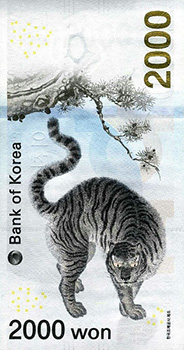Korean currency is called won, or Korean won. The hangul spelling is 원, hanja is 願, and won is the Romanization. It can also be written as KRW for Korean won. The symbol for won is a capital W with two horizontal lines passing through it; ₩. The name of currency used in the Korean peninsula has changed over the centuries, including myeongdojun, yang, and hwan, but from 1962 it has stably been won. North Korean won and South Korean won are not the same currency and it will take effort to see North Korean currency in the South.
To get into significantly deeper details and far more examples, see the Wikipedia page on Korean currency for a historical perspective and various links to related pages. If you want a listing of all the names, units, and subunits that Korean currency has been, see the Etymology of the Korean currencies. The other page you might want to see is their South Korean won page.
The Bank of Korea (한국은행, 韓國銀行, Hanguk Eunhaeng) (website, Wikipedia) is the central bank of South Korea and the issuer of South Korean won. Their headquarters in Seoul also has a museum named the Bank of Korean Museum (한국은행 화폐박물관, 韓國銀行 貨幣博物館, Hanguk Eunhaeng Hwapye Bangmulgwan) (website, Wikipedia). If you are visiting the Institute for Basic Science’s headquarters in Daejeon, you can take a ten minute taxi ride to the Currency Museum (화폐박물관, 貨幣博物館, Hwapye Bangmulgwan) (website, IBS website) owned by the Korea Minting and Security Printing Corporation.
To the best of our knowledge, there is no dedicated counterfeit currency investigatory agency in South Korea. If you come in contact with counterfeit money, contact your local police station (not the smaller substations) or the Bank of Korea which has branches in and outside of Seoul.
South Korean won has four types of coins and four types of bills in wide circulation. Smaller denominations are physically smaller and gradually grow in size. The smallest coin in circulation is bronze in color while the other three coins are nickel in color. The four paper bills are blue, red, green, and golden in color, in that order. Here is a composite image with the bills and coins in their respective sizes. If you want to see the images and words more clearly, click the picture to see a larger version of the image. Copyright of the various images on this page is owned by the Bank of Korea.
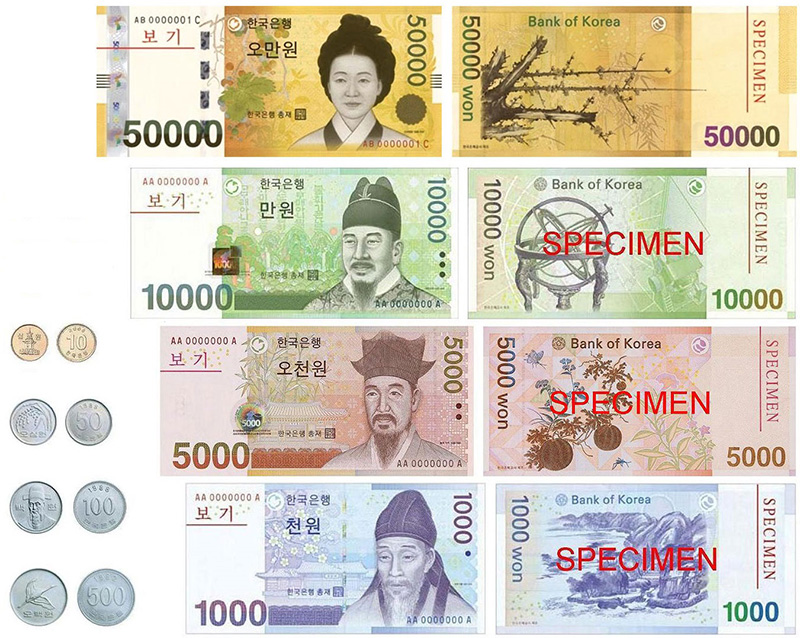
The smallest value coin you’ll see in circulation is the ₩10. It is copper-plated aluminum composed of 48% copper and 52% aluminum. The front side shows a Dabotap pagoda (다보탑, 多寶塔, dabotap, Wikipedia). The current version was first minted in 2006. It is 18 mm in diameter.


From 1983 to 2006, there was a 22.86 mm version of the ₩10 coin. The older version was more brass in color and you can find it on occasion but it is slipping out of circulation.


The next coin is the ₩50 coin. It is 70% copper, 18% zinc, and 12% nickel. At 21.6mm in diameter, it was just a little smaller than the outdated ₩10 coin. The front shows a stalk of rice. It has been in circulation since 1983.


The next coin is the ₩100 coin. This is a very common coin in circulation, perhaps the most common. It is 75% copper and 25% nickel. It is 24mm in diameter. The front shows naval commander Yi Sun-shin (이순신, 李舜臣, I Sunsin, Wikipedia). If you spend enough time in Korea you will hear about his turtle ships (거북선, 거북船, geobukseon, Wikipedia) and no doubt will see statues of him and/or these specialty naval vessels. This coin has been in circulation since 1983.


The last coin in wide circulation is the ₩500 coin. Like the ₩100 coin, it is 75% copper and 25% nickel. It is 26.5mm in diameter. The front shows a red-crowned crane (두루미, durumi, Wikipedia) and it has been in circulation slightly longer than the other coins as it started production in 1982.


From 1983 to 2006, there were two other coins in circulation; ₩1 and ₩5. The ₩1 was made entirely of aluminum, 17.22 mm in diameter, and had the Rose of Sharon (Wikipedia) on the front. This flower is the national flower of South Korea, so expect to see it from time to time, including on the Presidential Standard (president’s flag) where it is flanked with a pair of phoenixes.


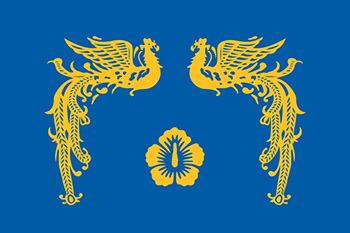
The ₩5 coin was 20.4 mm in diameter and was more brass in color as it was made with 65% copper and 35% zinc. It had a turtle ship on the front, which connects it to the ₩100 with Yi Sun-shin.


There are four kinds of paper currency in South Korea. As mentioned at the top of this page, smaller denominations are physically smaller and gradually grow in size. Each value has a different color as well, starting with blue, red, green, and golden in color, in that order. It is worth noting t hat none of the bills utilize a comma, e.g. ₩5000 is not written ₩5,000. Additionally, the ₩1,000 and ₩5,000 can be deposited in ATMs but cannot with withdrawn.
The first bill is ₩1,000, is blue in color, and has the philosopher and writer Yi Hwang (Wikipedia) on the front along with the educational institution Sungkyunkwan (Wikipedia) and plum flowers. The rear features the painting Gyesangjeonggeodo by artist Jeong Seon, pen nam Kyomjae (Wikipedia). The version currently in circulation was first introduced in 2007.
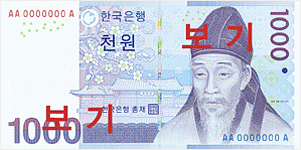

The next bill is ₩5,000, is red in color, and has the philosopher and writer Yi I (Wikipedia). The location is Ojukheon (Wikipedia) in Gangneung City, Gangwon Province as this is the birthplace of Yi I. The object is black bamboo as they grow in Ojukheon. The rear features a painting by the mother of Yi I.
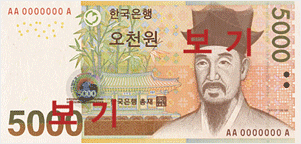
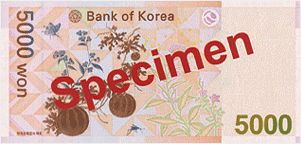
The next bill is worth ₩10,000, is green in color, and features King Sejong (Wikipedia). One of the kings to get the title “The Great”, he is known for creating the hangul alphabet system. We briefly mention him in the history section of this website. Behind Sejong is the traditional Korean folding screen Irworobongdo (Wikipedia) which is placed behind the throne in Gyeongbokgung Palace (Wikipedia) in Seoul. Vertical text in hangul from Yongbieocheonga (Wikipedia) is also on the bill as it was the first work of literature written in the phonetic alphabet. The rear shows Honcheonsigye (Wikipedia), an astronomical clock and Cheonsang Yeolchabunyajido (Wikipedia), a commonly used fourteenth-century Korean star map. This bill can be used in ATMs and can be confusing as the base unit in ATMs is 10,000 (만, 萬, man). For more information on this aspect of the number system, see the banking-related numbers section.
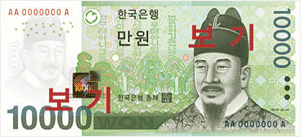
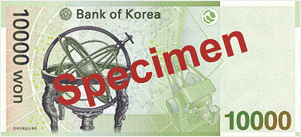
The last and most recently introduced bill is worth ₩50,000. It is golden in color and features the artist, writer, calligraphist, and poet Sin Saimdang (Wikipedia). This is the only instance of a female on South Korea’s currency. Behind her are several of her drawings and the rear features bamboo and a plum tree. This bill can be used in some but not all ATMs.
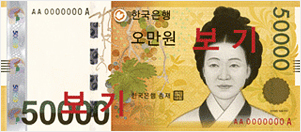
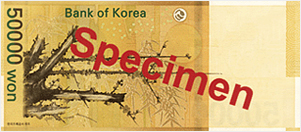
The Bank of Korea does make some specialty bills and coins. How often this happens is unknown to this author. The one instance that is known and can easily be cited, are the 2,000 won bills that were distributed by one bank during the 2018 Pyeongchang Olympics (website, Wikipedia). As there were seven sporting events (biathlon, ice hockey, curling, speed skating, ski jumping, luge, and bobsled) there were seven versions of this bill as the front featured one of the seven events.
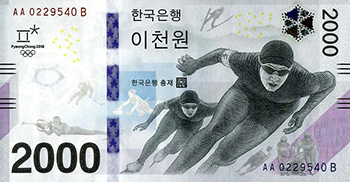
The rear of the bills were vertical and included a Joseon-era painting of a tiger and pine tree, named Songhamaenghodo (image on Wikipedia), by the artist Kim Hong-do, also spelled Gim Hong-do or stylized as Danwon (Wikipedia). While the author of this website was able to attend the Olympics, he found out about the special bills too late and would love to get a set.
